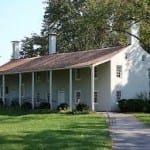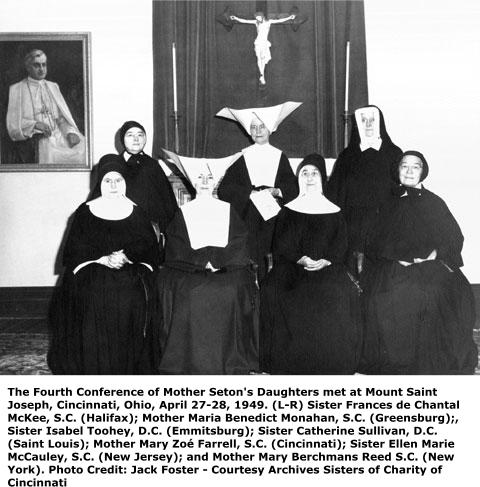March 25 th marks the 163rd anniversary of the union of Mother Seton’s Sisters of Charity with the Daughters of Charity. For more on the history and the difference visit this post from the Provincial Archives of the Daughters of Charity in Emmitsburg. This year Daughters of Charity will be celebrate on April 8th outside of Holy Week.
….
Our January 4, 2013 posting of Fr. Simon Bruté’s record of Elizabeth Ann Seton’s death prompted a question we often receive concerning the distinction between Sisters of Charity and Daughters of Charity.
In short, Mother Seton’s community was called the SISTERS of Charity of St. Joseph. Their spirit and charism was based on the charism of serving the poor established by Vincent de Paul and Louise de Marillac, who founded the DAUGHTERS of Charity in France in 1633.
Spiritually, the Sisters of Charity of St. Joseph’s were in the tradition of the Daughters of Charity. Canonically, they were not. The actual union between Mother Seton’s community in Emmitsburg and the French Daughters of Charity didn’t happen until 1850. While the community in Emmitsburg did unite with the French Daughters, other Sisters of Charity communties did not. “Sisters of Charity” and “Daughters of Charity” are often used interchangeably but they are in fact different communities.
The model community on which John Carroll and the French Sulpicians had in mind for Mother Seton’s community was the Daughters of Charity. The common rules brought to America from France in 1810 refers to that group as the “Filles de la Charité” – Daughters of Charity. In 1812 the rules of the Daughters of Charity were translated by Bishop Flaget – this translation is known as the American Rule. In the American Rule the name was changed to the “Society of Sisters of Charity.” St. Vincent de Paul and St. Louise de Marillac intentionally tried to disguise their group as the French government wanted women religious to stay in a cloister; so they did NOT call them Sisters. John Carroll and the Sulpicians, on the other hand, wished to identify this new group as women religious so they felt free to use that term. How did Mother Seton’s group refer to themselves, though? In “Numerous Choirs,” Ellin Kelly’s two-volume history of the Charities, Appendix A of Volume I has a transcription of the American Rule of 1812. Chapter II demonstrates how flexible the nomenclature was. Mother Seton’s group was called the Sisters of Charity of St. Joseph but on p. 244, we see that they are referred to “Sisters of St. Joseph” as well as “Sisters of Charity.” Those names are used interchangeably throughout. And while it would seem that the real distinction was made after some of the sisters merged with France in 1850, it’s interesting to note that up until the creation of today’s Province of St. Louise in 2011, official documents of the Emmitsburg Province still referred the these Daughters as the “Sisters of Charity of St. Joseph” — SCSJ.
Vincent and Louise’s desire to have the Daughters of Charity serving in the community rather than remaining in the cloister shows up in many ways. The Daughters of Charity, then and now, do not make lifetime vows. They make annual vows. The Daughters of Charity have a seminary, other communities have a novitiate. Women who enter the seminary are considered full members of the Company of the Daughters of Charity – there are no “temporary” and ”final” professions in the Daughters of Charity. The date that a Daughter of Charity enters the seminary is called her vocation date. Roughly five years after her vocation date she pronounces vows for the first time and renews those vows every year after that. Daughters of Charity all over the world renew their vows every year on or about March 25. The desire to not be cloistered also influenced the design of the Daughters of Charity habit. In Vincent and Louise’s time the habit was a French peasant dress with a very simple sunbonnet – the habit didn’t take on the look we associate with the Daughters of Charity (including the “winged” cornette worn until 1964) until the 19th century. Vincent and Louise wanted the first Daughters to blend in with the people they were serving, and so they dressed like them. The charism of serving the poor started by Vincent and Louise, along with many aspects of the DC community rules, were the basis for Mother Seton’s community. The DC habit was not, because Mother Seton’s community was not united with France during her lifetime. So Mother Seton’s community wore the “black cap” habit, not the cornette.
 For the more on the Setonian legacy in the USA visit
For the more on the Setonian legacy in the USA visit
From the Seton Heritage website…
Step back into the 19th century while you tour the Stone House in St. Joseph’s Valley, where the Sisters of Charity were founded July 31, 1809. The house was far from offering all the comforts Elizabeth Ann had so optimistically described in a letter to her dearest friend, Julia Scott. Sixteen people occupied four rooms, two upstairs and two down, with one of the smaller lower rooms used as a temporary chapel.
“You will hear a thousand reports of nonsense about our community, which I beg you not to mind. The truth is we have the best ingredients of happiness – order, peace, and solitude.”
–Elizabeth Ann Seton’s letter to Julia Scott, September 20, 1809
Main graphic courtesy of the Sisters of Charity of Cincinnati
Tags: Daughters of Charity, Sisters of Charity, Sisters of Charity Federation

